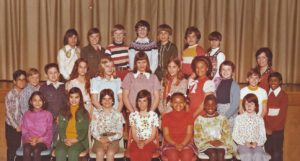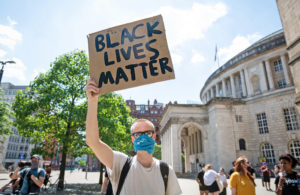For every major metropolis that painted BLACK LIVES MATTER on its streets two years ago, there were huge swathes of America where the whole movement felt like a distant diversion, similar to the current war in Ukraine. You knew it was happening, of course, and who the good guys were. You woke up each morning to fresh footage of this or that inspiring protest (or sometimes, to the news that the marching had devolved overnight into something worse). You worried for the safety of those caught in the conflict and hoped for positive change. But the front, the fighting, was far away.
This was especially true in elite liberal communities on America’s highly segregated coasts, including the part of Connecticut where I’ve lived for the past ten years. These towns are geographically diverse — from Scarsdale, New York, to Hillsborough, California, to Short Hills, New Jersey — but they have a unique collection of traits: a highly educated, Democrat-voting population; an astounding concentration of wealth; a median home price upwards of $1 million; and, most crucially, almost no black people at all.
Needless to say, these places aren’t usually big on racial awareness, save for the occasional self-conscious acknowledgment of their homogeneity. But as the Black Lives Matter movement swept the nation, the mounting social pressure to demonstrate one’s support forced a confrontation with what had long been undiscussed: how does one demonstrate a commitment to black lives when virtually none of them are being lived in your zip code?
The result was, to put it mildly, remarkable: a rash of extremely fancy white people performing near-hysterical levels of hyperawareness for an issue that had absolutely no material bearing on their lives. Black Lives Matter signs popped up like weeds in the front yards of multimillion dollar homes, in neighbourhoods where they would be seen by approximately zero black people save for the odd delivery man. Pricey boutiques hung Black Lives Matter signs in their windows. In Darien, Connecticut, a town with a black population of less than 1% and a median household income of $365,528 that regularly ranks it on lists of America’s wealthiest communities, a sea of white people in designer sunglasses marched down the leafy main street screaming, “No justice, no peace!” before gathering politely in a local park to listen to the main speaker: a black woman who had traveled up from Brooklyn just for the occasion.
It’s hard to overstate the irony of a town like Darien, whose racial demographics are in part a direct result of the infamous “white flight” from nearby New York City in the Seventies, having to import people of colour from that same city in 2020 in order to demonstrate its commitment to social justice. It also speaks to the peculiar relationship that places like Darien have with more local communities of colour. The town where I live, Norwalk, is just five miles down the road from Darien and has a 15% black population — but not only did Darien not ask its black next-door neighbours to participate in its Black Lives Matter protest, they also recently rejected a plan to allow just over a dozen Norwalk kindergarteners into their top-ranked school district. And so the de facto segregation of these communities has always served to insulate them from ever truly feeling the impact of America’s racial reckonings — or from having to think about them once they’re over.
Two years after George Floyd’s murder, in some cities, ubiquitous murals, statues, and street art stand in commemoration of the moment; in others, the boarded-up remains of empty, smashed-out storefronts are a stark reminder of the revolution’s less-glorious moments. Many of the places where the movement found the most purchase are now struggling to realise its promise, with rising crime rates serving as a direct challenge to progressives’ dreams of defunding the police.
In Connecticut’s wealthy enclaves, some Black Lives Matter signs are still there — albeit faded by the sun and a bit tattered around the edges, in what seems like almost too perfect a metaphor for the legacy of BLM in elite liberal communities. But in 2020, those three words weren’t just a slogan, but a brand, as conspicuous a class signal as owning a Birkin bag and knowing which fork to use.
Long before the raised fist became an high-class accessory, writer Rob Henderson identified the rise of what he called “luxury beliefs” among privileged progressives — including the attention-seeking brand of anti-racism that became so ubiquitous that summer. “Affluent whites are the most enthusiastic about the idea of white privilege”, he wrote, “yet they are the least likely to incur any costs for promoting that belief. Rather, they raise their social standing by talking about their privilege. In other words, upper-class whites gain status by talking about their high status.”
That a person can successfully preserve his power by flagellating himself for undeservedly having so much of it certainly goes a long way toward explaining the position that communities like Darien took vis-a-vis Black Lives Matter. (See also: the popularity of “defund the police” in communities that are safe and wealthy enough to be wholly unconcerned with crime.) One year after the peak of the protests, the New Yorker noted that all this shrill awareness-raising had been largely nothing but noise: people in positions of influence had “mastered the language of racial contrition, lamenting the conditions that nourish inequality, while doing the bare minimum to change them”.
The people who spent an afternoon parading around and shouting in their pretty town square before returning to business as usual in their comfortable, lily-white neighbourhoods may not have been consciously engaging in a cynical performance, but they nevertheless seemed to grasp the game intuitively: you can be the living, breathing embodiment of privilege, but nobody will ask you to give it up if you just make enough embarrassed noises about it — and, perhaps, if you make a generous enough donation to the cause, to the tune of the $90 million raised by BLM in 2020 alone.
Here, the mind boggles: not just at the sheer volume of both attention and money generated by this movement among people who have no skin in the game, but at their utter incuriosity about just where their money went. When stories surfaced earlier this year about the shady misappropriation of Black Lives Matter funds to, among other things, purchase a $6 million party house in Los Angeles, the response from donors was revealing in that there was hardly a response at all.
But of course, there was no outrage. Those donations were indulgences: a tax-deductible expense after which you, the giver, were free to keep living your privileged life. Whether the money did anything to help was immaterial. The point was to give, and to be able to say you gave.
But then, the intersection of wealthy white Left-leaning lives with the black ones which they profess to value has always been thus. As genuinely progressive and avowedly anti-racist as these good white liberals may be, the only black people they encounter day to day are invariably paid to be there. The gardener. The maid. The personal trainer. An endlessly rotating series of cashiers and delivery people. In lieu of actual connection, transaction. In lieu of relationships, reparations.
And in lieu of using their influence to push for actual change, the most powerful people in America — the CEOs, the philanthropists, the hedge fund managers, the people who sit on boards — raise an empty fist. At home, they plant a Black Lives Matter lawn sign and write a check for the cause; at work, they sign a bigger check alongside a polished solidarity statement crafted by the in-house PR team for maximum engagement. It is all signal and no substance, designed to mask a deep and abiding investment in the status quo — as demonstrated by what happens when you ask the folks with the lawn signs how they’d feel about a low-income housing unit being built in their neighbourhood.
Which brings us to the question of what will happen now, when Black Lives Matter is no longer the hot new trend, the must-have status symbol. Already, the black-and-white BLM banner has been largely replaced in the progressive Twittersphere by the Ukrainian flag. And in a world dominated by performative activism, where causes are less about principles than they are about keeping current, this is all but inevitable. How long will it be before the conflict in Ukraine is eclipsed, too, by some shiny new tragedy?
And sometime soon, if it hasn’t happened already, the glue holding together the last Black Lives Matter sign in the front yard of someone’s multimillion dollar mansion will give way. The hedge fund manager who lives there will come home from work to find it face-down, covered in dirt, curling with damp at the corners. And maybe he’ll pause a moment before tossing it in the trash; maybe he’ll make a mental note to order a new one from wherever that was. But by the time the men who collect the garbage come to take the bin away, its contents will have been long since forgotten — as if it was never there at all.
Disclaimer
Some of the posts we share are controversial and we do not necessarily agree with them in the whole extend. Sometimes we agree with the content or part of it but we do not agree with the narration or language. Nevertheless we find them somehow interesting, valuable and/or informative or we share them, because we strongly believe in freedom of speech, free press and journalism. We strongly encourage you to have a critical approach to all the content, do your own research and analysis to build your own opinion.
We would be glad to have your feedback.
Source: UnHerd Read the original article here: https://unherd.com




